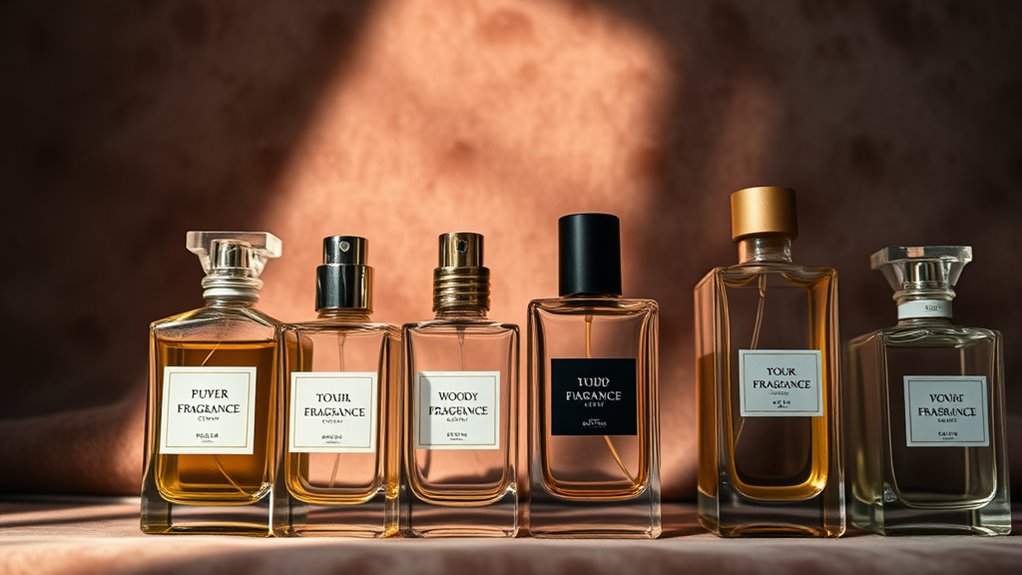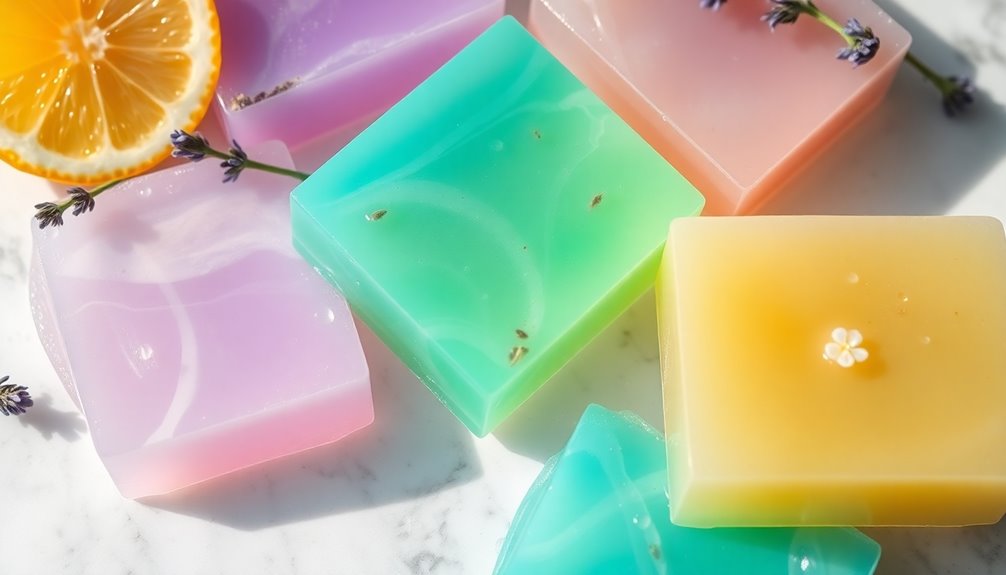Fragrance families are categories based on the main scent themes in perfumes, like floral, woody, oriental, or fresh notes. They help you understand the overall vibe of a scent and make it easier to choose or layer fragrances. Knowing these families lets you create personalized scent combinations that suit your style or mood. Keep exploring, and you’ll discover how to mix fragrances creatively to develop your signature scent.
Key Takeaways
- Fragrance families are broad categories based on scent characteristics, such as floral, woody, oriental, and fresh.
- They help in understanding, selecting, and organizing perfumes according to scent profiles.
- Fragrance families guide in matching perfumes to personality, mood, or occasion.
- Combining scents within or across families creates personalized and complex fragrances.
- Learning about fragrance families enhances your ability to experiment and develop a signature scent.

Have you ever wondered how perfumes are categorized into different scent groups? It’s a fascinating system that helps you better understand your favorite fragrances and how they work together. Fragrance families are broad categories based on the dominant scent characteristics, such as floral, woody, oriental, or fresh. Recognizing these groups can be a game-changer when it comes to selecting perfumes that match your personality or mood. To make the most of your fragrance collection, you should explore scent combination tips and fragrance layering techniques, which allow you to create unique, personalized scents by blending fragrances within or across these families.
For example, if you love floral scents, you can experiment by layering a soft rose perfume with a citrusy scent to add brightness. When combining scents, keep in mind that fragrances within the same family often complement each other naturally, creating harmony and depth. Conversely, pairing fragrances from different families can produce interesting contrasts, like a spicy oriental with a fresh citrus, resulting in a more complex aroma. To get started, consider the scent combination tips: start with a light base, like a subtle floral or fresh scent, and then add a few drops of a more intense fragrance, such as an amber or woody note. Always test your blends on your skin or a blotter before committing, so you can gauge how they interact over time.
Fragrance layering techniques are also essential for customizing your scent experience. Think of layering as building a scent story—begin with a scent that acts as your foundation, then add layers to enhance or modify it. For instance, applying a floral body lotion before spritzing on a floral perfume can amplify the scent, while a woody fragrance layered over a citrus scent can ground the freshness. Remember, less is often more when layering; start with small amounts and gradually add until you reach your desired balance. Additionally, understanding headphone connection types can be useful if you want to listen to music or tutorials while experimenting with scents. By understanding fragrance families and practicing scent combination tips, you’ll unravel endless possibilities for creating your signature scent. It’s all about experimenting and discovering what resonates with you personally. Whether you prefer a subtle elegance or a bold statement, knowing how to navigate fragrance families and employ layering techniques empowers you to craft scents that truly reflect your style and mood.
Frequently Asked Questions
How Do Fragrance Families Influence Scent Longevity?
Fragrance families influence scent longevity by guiding your scent layering techniques and helping you choose complementary scents. For example, floral or woody fragrances often last longer, allowing you to enhance their longevity with appropriate layering. Using fragrance family classification methods helps you understand which scents work well together, ensuring your perfume stays vibrant throughout the day. By selecting the right family, you can maximize the lasting power of your fragrance.
Can a Perfume Belong to Multiple Fragrance Families?
Yes, a perfume can belong to multiple fragrance families. You might find yourself layering scents or exploring various perfume classification systems, which often blend categories. Fragrance families aren’t rigid; they’re fluid, so complex concoctions may straddle several groups. By understanding this, you can experiment confidently with fragrance layering, creating unique scents that express your style while appreciating the beautifully blended boundaries within perfume classification systems.
Are Fragrance Families Culturally Universal or Region-Specific?
Fragrance families are not entirely culturally universal; they often reflect regional fragrance variations and cultural scent preferences. You’ll find that certain scents, like sweet or spicy notes, are popular in some regions, while others prefer fresh or woody scents. These differences influence how fragrances are classified across cultures. So, while some fragrance families are recognized worldwide, regional and cultural nuances shape how fragrances are perceived and categorized in different parts of the world.
How Do Fragrance Families Impact Pairing With Personal Chemistry?
Fragrance families substantially impact your personal scent compatibility by guiding fragrance matching techniques. When you choose scents within a family that complements your skin chemistry, they blend more naturally, enhancing your overall aroma. Experimenting with different fragrance families helps you discover what works best for your unique chemistry. Pay attention to how scents evolve on your skin, and adjust your choices to find the perfect match for your personal style and chemistry.
Do Fragrance Families Change With Evolving Scent Trends?
Yes, fragrance families do change with evolving scent trends. As scent classification advances, perfumers explore new combinations, blending traditional categories with innovative notes. This fragrance evolution leads to the emergence of hybrid families or new classifications, reflecting changing preferences. You’ll notice that scent trends influence how fragrances are grouped, making the landscape dynamic. Staying aware of these shifts helps you find scents that match your evolving personal style and current trends.
Conclusion
Now that you know about fragrance families, you can confidently explore scents that truly match your personality. Did you know that nearly 70% of people tend to stick with just a few favorite fragrance families? Imagine walking into a room and leaving a memorable impression with a scent that’s uniquely you. So, go ahead—discover your signature fragrance and make every moment smell unforgettable!










